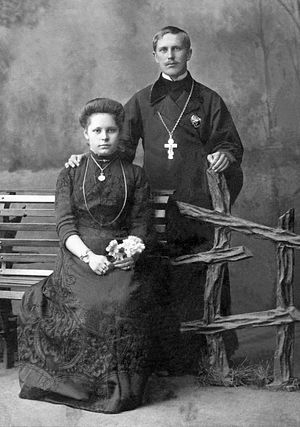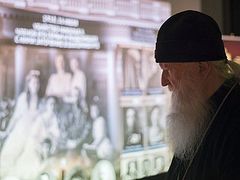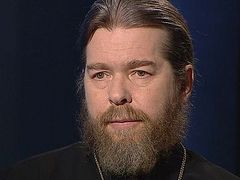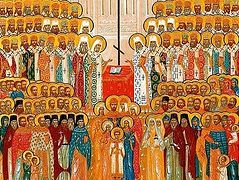St. Alexander was born on September 23, 1889, in the village of Russkaya Tsilna of the Simbirsk district of the Simbirsk province of the Russian Empire to the family of Priest Fyodor Vasilievich and his wife Claudia Nikolaevna Gnevushev. In 1912, he graduated from the Simbirsk Theological Seminary and for some time served as a psalm-reader at the church of his native village.
On March 9, 1914, he was ordained a priest and sent to the Church of the Nativity of Christ in the Aleykino village of the Simbirsk district, appointed the headmaster and teacher of the parochial school there and of a Zemstvo [Zemstvos were elective district and provincial councils/assemblies in pre-revolutionary Russia; here: a school founded and run by a Zemstvo] school in a neighboring village. In 1921, Fr. Alexander was transferred to the Church of the Holy Archangel Michael in the village of Komarovka, in 1923, to the village of Shumovka of the Simbirsk district, and in 1925, to the village of Bryandino of the Melekess [since 1972, Dimitrovgrad] district.
In 1929, the Soviet authorities all over Russia undertook a campaign to close churches and remove church bells. In January 1930, local authorities and atheist activists in Bryandino launched a campaign to take down the bells of the village church. The authorities who intended to shut down the church during the campaign demanded that the priest pay the taxes on it. Since Fr. Alexander was unable to pay, he was charged with tax evasion, and on January 9, 1930, a village council member came to him with witnesses to confiscate his property. On January 13, Fr. Alexander celebrated the Vigil service and delivered a sermon that was afterwards interpreted by the authorities as anti-Soviet propaganda. On the following morning after the Liturgy the priest stepped onto the ambo with the cross and addressed the congregation; he said that the services could stop any day, for there were plans to confiscate the church for the collective farm’s (kolkhoz’s) needs. He called upon the faithful to offer up their fervent prayers to God and implore Him to deliver them from the attacks of godless people.
The parishioners began to cry; seeing their pain, Fr. Alexander himself shed tears and having laid the cross on the analogion, entered the altar. Meanwhile, the choir was singing the kontakion that is normally sung during Lent: “My soul, my soul, rise up! Why art thou sleeping? The end is drawing near…”
On January 15, all the villagers assembled to consider the plans to remove the church bells; around 300 people were present in all. However, everyone but the atheist activists was against the demolition of the bells, and the godless men were unable to make the majority change their minds.
On the following day around 500 parishioners gathered near the church in order to prevent the atheists from taking down the bells and closing the church. Some teenagers with their mothers’ consent climbed up the bell tower and began to toll the tocsin. The village activists approached the crowd, but as soon as the believers started raining threats upon their heads the godless men dispersed. The faithful kept watch by the church for several days, but the authorities made no more attempts to seize it.
In early April, when Fr. Alexander was away visiting his relatives in Simbirsk, representatives of the Joint State Political Directorate [OGPU—the secret police in the USSR between 1923 and 1934] arrested several activists who were trying to save the church. On February 15, an indictment was issued. The investigators wrote: “Since the beginning of January, 1930, local village public organizations have been agitating for the removal of bells from the local church. Trying to counteract this campaign, the village priest Gnevushev… took advantage of the religious prejudices of the masses and launched a strong anti-Soviet agitation among believers by disseminating provocative rumors that the church would allegedly be used for the collective farm’s needs. While performing religious ceremonies, Gnevushev violated Church rules in order to stir up the believers’ sentiments by introducing the singing of ‘moving’ Lenten hymns, which are normally not sung outside Lent… After preaching a solemn anti-Soviet sermon, Gnevushev went into the altar with tears in his eyes, while the choir was singing the ‘moving’ Lenten hymn, ‘My soul, my soul, rise up! Why art thou sleeping? The end is drawing near…’ The whole congregation (around 200 people) burst out crying… As a result of the anti-Soviet activity of Gnevushev and his followers… in the morning of January 16, 1930, a crowd of 400 or 500 gathered outside the church in order to deal shortly with representatives of the local authorities and the poor activists who were trying to call the band to order and explain to them that nobody was going to take the church away from them…[1]”
On his return from Simbirsk, Fr. Alexander went to the forest to collect firewood. At that time the investigation of the detained people’s case was completed, and Fr. Alexander was wanted by the police as “fugitive from justice”. As soon as the priest came back home on February 22, he was interrogated and arrested on the following day. In court the new martyr pleaded not guilty. On February 28, the priest was interrogated again. Since the representatives of the Joint State Political Directorate were accusing him of “counter-revolutionary agitation” and forcing the choir to sing a Lenten kontakion at the church, Fr. Alexander replied, “I can attest to the fact that the people were crying at the church, but I don’t know why exactly. When I came out of the sanctuary with the cross, I saw everybody, both women and men, crying; I shed a few tears as well, then laid the cross on the lectern and went back into the sanctuary. At the same time the left choir indeed began to sing the kontakion, ‘My soul, my soul…’, although it is sung only during Lent. I knew that it contradicted the Church Typicon but didn’t want to interfere.[2]” Wishing to justify himself, the priest said that although he knew that the churches were being stripped of their bells all over the country, he did not want to be involved in the opposition movement as he did not feel he had enough authority to do it. Besides, he added that while it was not very good that a large crowd had gathered outside the church, he was afraid to intervene.
On April 15, 1930, the troika of the Joint State Political Directorate Plenipotentiary Representation sentenced Fr. Alexander to execution by firing squad. Priest Alexander Gnevushev was martyred on February 28, 1930, and a relevant statement was drawn up: “The corpse of Gnevushev who was executed by shooting has been buried on the territory of a cemetery near Ulyanovsk [the modern name for Simbirsk] close to the Strizhev Ravine in a grave that was dug to a sufficient depth.”[3]
***
New Hieromartyr Alexander Gnevushev, priest in Bryandino, was canonized for universal veneration at the meeting of the Holy Synod of the Russian Orthodox Church of the Moscow Patriarchate on August 17, 2004.
From: The Lives of the New Martyrs and Confessors of Russia in the Twentieth Century, April (Tver, 2006), 156-159.




